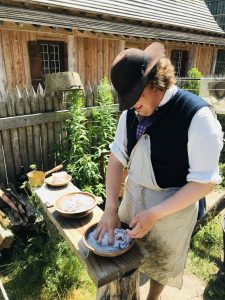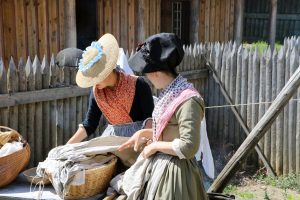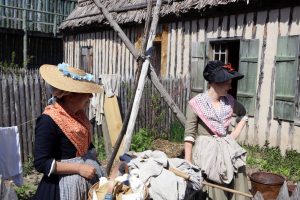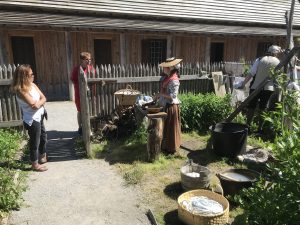

Imagining laundry in the past will no doubt bring up images of scrub boards, large kettles of water and lots and lots of soap, all handled by housewives as part of their daily routine. However, laundry technology and methods used before the modern era were often highly specialized, and usually completed by professional laundresses.
Researching the 18th century washing process reveals that each laundress likely had her favorite techniques for removing stains and cleaning clothes. Some of these may have been learned in person, while others may have come from books, newspapers or pamphlets that were published at the time. Some of these methods may seem foreign and odd to us today, but when we look closer into the chemistry behind some of them, they begin to seem, in truth, rather brilliant.


Quite often, linens were soaped after they were bucked. Each item was pulled from the bucking tub and spots were gently rubbed between the hands to further loosen the dirt and grease. As soap is worked and kneaded into the linen it acted like a middleman by bringing oil and water together so that the dirt and grease left after bucking can be rinsed away.
Soap works due to its unique molecular makeup. Each soap molecule has both hydrophilic (attracted to water) and hydrophobic (repelled by water) parts. When soap is added to dirty water, the individual soap molecules arrange themselves so that the hydrophobic parts surround the grease, oil, or dirt molecules, while the hydrophilic parts point outwards towards the surrounding water molecules. As soap molecules gather together around the dirt or oil, they form molecular balls called micelles. The dirt or oil is trapped inside the micelles, separate from the water, and so can easily be rinsed away thanks to the hydrophilic shell surrounding it.


The steps mentioned above could be supplemented with really interesting stain removal techniques. One of these, vinegar, can mix with water, oil, alcohol and almost any other kind of liquid. When dissolved in water, the vinegar breaks down into two components, hydrogen and acetate. The hydrogen will try to bond to any molecule that it encounters and weakens the molecule’s structure. This quality makes the hydrogen great at cleaning stains made from substances, like coffee, tea, grass, blood and rust. The second component, acetate, reacts with molecules in grime and changes their makeup so that water can dissolve them. Vinegar also gets rid of odors by killing off the bacteria and fungi that cause them. Its acidic nature destroys the cell structure of bacteria that cause smells trapped in fabric.


Our historic laundresses had many other ways to keep their customers clean and healthy. In addition to specific stain treatment for specific fibers, they also added steps to the process that could include starching, blueing whites, ironing, bleaching and of course drying. For more details about how laundry worked in the 18th century, and to see the process in action, visit us at Colonial Michilimackinac. Please also consider joining Mackinac Associates, which makes many of our onsite programs and exhibits possible.








